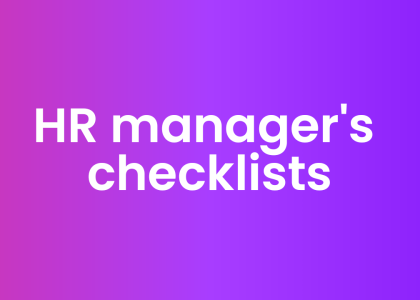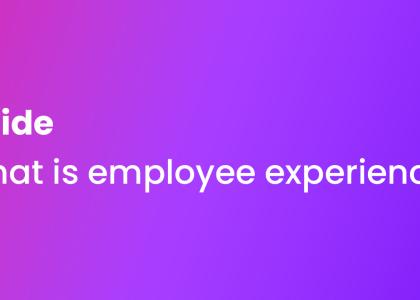Why employee morale matters
You’ve got a spreadsheet full of KPIs, and morale probably isn’t one of them. But it affects how likely you are to achieve them all… here’s how.
Better employee health and wellbeing
There’s a fine line between low workplace morale and poor mental health. Workplace worries can soon turn into full-blown anxiety, while bouts of unhappiness can escalate into depression if left unchecked.
Research in the British Medical Journal backs up this link, suggesting that workers subjected to management practices that don’t prioritise their wellbeing are three times more likely to be diagnosed with depression. Dr Zadow, the study’s author, explains that “Companies who fail to reward or acknowledge their employees for hard work, impose unreasonable demands on workers, and do not give them autonomy, are placing their staff at a much greater risk of depression.”
According to the HSE, around half of all ill-health reports in UK workplaces are due to work-related stress, depression, or anxiety. This is costing organisations big time, with mental health issues now behind 46% of all workplace costs. With all of this in mind, leaders must be able to prevent and manage low workplace morale before it has serious consequences.
Productivity and discretionary effort
When people feel good about their jobs, they go the extra mile without being asked. This discretionary effort translates into better performance from your team, whether that means faster innovation, smoother customer service, or something else. Research shows time and again that engaged employees are both more productive and more profitable; and morale and employee engagement go hand in hand.
Things look very different when morale is weak. Not only will your team members put in less effort, but they may not even be at work in the first place. In fact, the CIPD has found that poor mental health is the leading cause of long-term absence, with factors including workload and management style.
Retention
Here’s a familiar scenario: an employee is thinking of leaving… not because they hate the job itself, but because being at work is no longer rewarding. Perhaps they feel micromanaged, left out of the loop, or simply underappreciated. And as a result, they’re off to pastures new.
Each time this happens, it costs you, and Deloitte recently revealed that 40% of employee turnover costs are now down to mental health. From recruitment to training new people, losing experienced staff drains time and funds from your business, and keeping them fulfilled can help you prevent this.
Business culture and resilience
Morale goes beyond individual employees or even whole teams. When morale is high throughout your organisation, it’s able to weather change and recover from setbacks more quickly. At the same time, employees are more collaborative, innovative, and adaptable, powering the business towards its goals. Good morale strengthens your entire culture.
The current state of employee morale in the UK
Morale is clearly vital to any organisation. But before we look at how to improve yours, let’s establish what employee morale looks like in the UK right now, and how we got there in the first place.
A national morale crisis
81% of British businesses report low staff morale, and many say this lowers productivity. If you’re finding that a large portion of your employees no longer seem engaged, you’re not alone.
Declining enthusiasm
The CIPD Good Work Index (2025) report shows only around half of UK workers feel enthusiastic “always or often”, while another half admit to feeling bored some or all of the time. Alarmingly, 37% even report feeling miserable.
Low engagement
Gallup’s 2024 survey found that only 10% of UK employees are "actively engaged" at work, making us one of the least engaged workforces in the world. This is costing the UK economy a whopping £257 billion each year.
Cost-of-living pressures
According to M.E.L Research, 43% of UK workers in 2023 said their motivation or morale had dropped because of rising costs. When people are worried about paying the bills, they have less of the energy and enthusiasm needed to do their best work.
Changing levels of flexibility
Expectations have shifted since COVID, and most workplaces now ask employees to be in the office at least some of the time. But it’s important to note that most people still value flexibility at work; while 74% of UK employees prefer hybrid work, just 2% of hybrid workers would like to be in the office full time instead. The job site Indeed has even found that many employees would take a pay cut for more flexible work.
Waning trust in leadership
Just 38% of UK employees trust their senior leaders, which is bound to affect morale.
Which factors boost employee morale the most?
If you’re struggling with morale in your organisation, you need to know which factors make the biggest difference before you can invest time and effort in making changes.
Fair and timely pay
The CIPD Good Work Index defines fair pay and financial security as central to good work. As the cost of living continues to climb, make sure your pay and financial benefits don’t fall too far behind. You can also ease the pressure by offering other benefits such as earned wage access and financial education resources.
Also, keep in mind that few things erode trust faster than late or incorrect pay, and 50% of employees would consider leaving if their pay was repeatedly wrong. A robust payroll solution is essential to paying employees correctly and on time without fail, resulting in employees who are more likely to go out of their way to help the business succeed.
Work-life balance
As we’ve already seen, rigid working arrangements are losing favour, and allowing some choice over where and when people work signals both trust and respect for your employees.
The Flexible Working Act (2023) now allows workers to request flexibility from day one, so be prepared to respond fairly to any proposals that come your way.
Recognition and leadership
Feeling invisible or undervalued chips away at morale, and the CIPD has found that 87% of employees who feel heard by their employer are more engaged at work.
If you want employees to feel truly listened to, leaders must be visible, approachable, and open to feedback. On top of this, it’s important to recognise and reward employees for a job well done.
Wellbeing and mental health support
Ignoring mental health is both unkind and unwise. According to the CIPD, half of organisations with strong employee wellbeing programmes say these have improved staff morale and engagement. Many even report lower sickness absence and higher retention rates following wellbeing initiatives.
Just as safety is non-negotiable for your business, wellbeing must be a priority when it comes to building an engaged, productive workforce.
Development and career growth
Most employees want to grow and develop with their organisation rather than standing still, and the CIPD’s focus on good work includes skills and fulfilment as well as fair remuneration.
Consider whether you offer your people an exciting career or just a job. No matter how attractive a package you give someone, at some point they’re likely to want to take the next step… whether that’s with you or another employer.
Despite this, the CIPD’s 2023 Learning at Work report reveals that a fifth of learning and development professionals face lack of buy-in from managers when trying to support organisational goals.
An inclusive culture
People want to belong, and they expect to see fairness and equality baked into company culture. In fact, two thirds of jobseekers cite diversity and inclusion as top priorities when selecting an employer, while inclusive teams are at least 35% more productive.
Meeting your legal obligations is the bare minimum, not the goal, and good employers bring their diversity, equality and inclusion policies to life rather than leaving them in a dusty corner of the intranet.
Regulations to be aware of
To improve employee morale, you need to go beyond regulations. But you must also be aware of your legal responsibilities so you can stay compliant and ensure employees get what they’re entitled to. Here’s an overview of the key laws that relate to workplace morale.
Employment Relations (Flexible Working) Act 2023
- Employees can request flexibility from day one of their role.
- They can make up to two flexible working requests every 12 months.
- Employers must respond within two months.
- As an employer, you must consult with an employee before rejecting their flexible working request.
Working Time Regulations 1998
- Employees must not work more than 48 hours each week on average, unless they opt out of this limit.
- Workers are entitled to at least one 20-minute break when working for more than 6 hours.
- They must be allowed at least 11 hours of rest between shifts, and 24 hours between each 7 working days.
Managing work-related stress
The Health and Safety at Work Act requires you to treat work-related stress just like any other aspect of health and safety. It’s your duty to ensure the health, safety, and welfare of your people while they’re at work.
Actionable strategies for improving morale
You now have a solid understanding of why employee morale matters so much to your organisation, and the things that boost or weaken it. Next, let’s explore some strategies that bring all of this together to help you keep your people happy and motivated at work.
Recognition programmes
A quick “well done” won’t cut it, and employees need real incentives to perform at their best. To show your people you appreciate their hard work, you can:
- Run quarterly or monthly award programmes such as “employee of the month”; employees could be nominated by peers to get everyone involved.
- Celebrate wins during team meetings.
- Share team members’ achievements more widely by including case studies or interviews in company communications.
- Consider offering bonuses, vouchers, or other rewards for great work. Make sure any financial incentives are clearly tied to achievable targets.
Flexible working options
There’s strong proof that employees value flexibility. Here’s how you can balance the needs of your people with those of your business:
- Create a clear flexible working policy, such as requiring a specific number of days in the office each week. Inconsistent rules between teams can breed bitterness and distrust.
- You could also offer options like job shares or compressed schedules that support those with extra personal responsibilities.
- Train managers to fairly assess flexible working requests.
- Encourage a culture that values outcomes and autonomy over presenteeism.
Wellbeing initiatives
People want tangible support, not gimmicks. Initiatives that make a real difference include:
- Employee assistance programmes that offer confidential counselling at any time
- Mental health and resilience training for everyone
- Trained mental health first aiders who can signpost colleagues to the right services
- Carrying out stress risk assessments and adjusting workloads if necessary
- Checking in with employees regularly in one-to-ones
- Openly talking about mental health throughout the business
Employee voice
Employees need to know that what they think and say matters, and that they can have a real impact on how the business works. You can achieve this with:
- Regular pulse surveys that offer quick, up-to-the-minute insights into employee experience
- Digital forums where employees can share thoughts and feedback; the right HR software is vital here
- Regular “ask me anything” sessions with leaders
- Responses to employee feedback through internal communications; this should include regular progress updates for longer projects
Career development
No one wants to feel stuck in one place, even if they enjoy their job right now. Here’s how you can show employees they have a bright future with your organisation:
- Work with each employee to map out a career pathway that supports their own and the business’s goals.
- Leave room in the budget for the training and development people need to reach these goals.
- Run mentoring programmes so colleagues can develop each other.
- Give employees access to a digital learning platform that lets them take control of their own development.
Measuring impact
Improving employee morale is no easy task; so how do you prove your strategies are working? After all, you’ll need to justify costs to leaders, and you’ll also need to be able to refine your approach over time. Here are some of the most effective ways of measuring return on investment.
Employee engagement surveys
Engagement surveys are one of the clearest indicators of whether employees feel supported and engaged. When designed well, they uncover how connected people feel to their teams and the wider organisation, and which factors are impacting this the most.
Pulse surveys, anonymous questionnaires, and digital feedback tools help you track how attitudes evolve over time so that you can clearly link employee morale to changes in your organisation.
Turnover, absenteeism and performance
While surveys unearth the reasons behind low morale, these metrics show the impact it’s having on your organisation. If employees are leaving in high numbers, are frequently off with stress, or are putting in less effort, workflows will soon come to a halt.
So keep an eye on turnover rates and absences, and make sure you’re measuring the most valuable key performance indicators when it comes to productivity. That way, you’ll know when things are going well, and you can also take action as soon as things start to slip.
Knowing what you want to achieve
Measuring all of this relies on knowing what good looks like in the first place. For example, you need to know what level of employee churn is too high, and what you expect each team and individual to deliver.
As soon as you notice something isn’t right, you should then set SMART (specific, measurable, achievable, relevant and time-bound) objectives to turn things around. For instance, you might aim to reduce stress-related absences by 15%, eliminate payroll mistakes, or double how satisfied employees say they are with their work – all within a set period of time.
Analytics dashboards
You no longer need to spend hours piecing disparate information together to judge the state of employee morale in your business. Modern HR systems come with built-in analytics tools that help you measure this by combining different touchpoints, from attendance and performance to training completion.
Our People First softwore even includes AI-powered sentiment analysis to give you meaningful insights into how your people feel about work. With advanced data analysis, you can identify blind spots and act quickly before small issues grow into big ones.
Boosting morale with People First
Explore our HR and payroll software to boost employee morale by creating a great employee experience, tracking the metrics that matter, and getting pay and benefits right every time.



